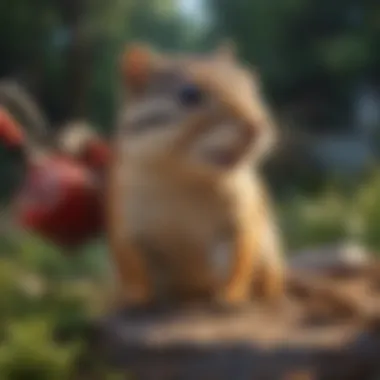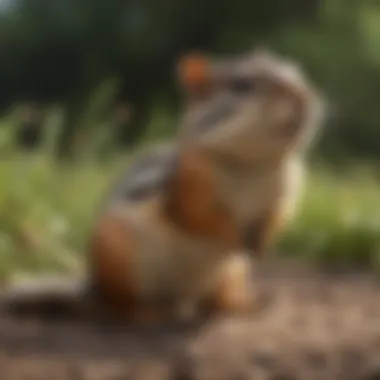Expert Guide: How to Hire the Best Chipmunk Exterminator for Effective Removal


Preventive Pest Control Strategies
House Exterior Protection
- Tips for sealing cracks
- Clearing debris
- Preventing pests from entering
Yard Maintenance
- Essential yard care routines
- Methods for keeping yard pest-free
Indoor Cleanliness
- Expert cleaning tips and techniques
- Maintaining a pest-resistant indoor environment
Garbage Disposal
- Efficient waste disposal methods
- Importance of proper garbage disposal
Other Pest Prevention Strategies
- Innovative ways to safeguard your home
Identifying Pest Risk Areas
Moisture Prone Areas Inspection
- Identifying damp conditions
- Tips for preventing infestations
Crack and Crevice Inspection Guide
- Importance of inspecting access points
- Strategies for sealing cracks and crevices
Greenery Inspection for Pest Risks
- Understanding greenery's impact on pests
- Guidelines to maintain pest-free yards
Additional Pest Risk Areas
- Miscellaneous pest risk areas and preventive measures
Effective Pest Control Methods
Natural Repellents for Pest Control
- Safe and effective natural solutions
- Use of essential oils, herbs, and plants
Chemical Sprays for Pest Control
- Safe usage of professional sprays
- Eradicating pests with chemical solutions
Pest Traps: Effective Pest Control Solutions
- Setting up and using pest traps
- Capturing and removing pests safely
Biological Control Methods for Pest Prevention
- Using natural predators for pest management
- Environmental-friendly pest control techniques
Other Pest Control Methods
- Innovative pest control methods beyond traditional options


Pest Species Identification
Common Insects in Home Pest Control
- Recognizing and managing insect infestations
- Types of insects like ants, cockroaches, and spiders
Identifying Rodents for Pest Prevention
- Tips for identifying and preventing rodent invasions
- Types of rodents including mice and rats
Bird Species Impacting Home Environments
- Addressing bird-related issues around the home
- Troublesome bird species in residential areas
Dealing with Wildlife on Your Property
- Handling wildlife encounters effectively
- Behavior and control measures for wildlife species
Miscellaneous Pest Species Identification
- Managing lesser-known pests effectively
DIY Pest Control Techniques
Homemade Pest Control Solutions
- Eco-friendly homemade pest control remedies
- Protection against pests using simple DIY methods
Using Essential Oils for Pest Control
- Repelling pests naturally with essential oils
- Creating a bug-free environment at home
Effective Pest Traps and Barriers
- Setting up traps and barriers for pest control
- Controlling and preventing pest infestations
Top Reputable Pest Control Brands
- Products for home pest management from trusted brands
- Safeguarding your home with effective solutions
Miscellaneous DIY Pest Control Techniques
- Unique solutions for various pest issues at home
Introduction
In today's urban landscape, dealing with chipmunk infestations has become a pressing issue for many homeowners. Understanding how to choose the right chipmunk exterminator is crucial in ensuring the safety of your property and family. This comprehensive guide aims to shed light on the intricate process of selecting a qualified professional to handle these pesky rodents effectively. By delving into the various aspects of chipmunk control, readers can make informed decisions to address infestations swiftly and efficiently.
Understanding the Need for a Chipmunk Exterminator
Signs of Chipmunk Infestation
Chipmunk infestations often manifest through distinct signs that are crucial to identify early on. Common indicators include gnaw marks on structures, scattered food remains, and burrow holes in gardens or lawns. Understanding these signs is key to promptly addressing infestations before they escalate further. By recognizing these tell-tale signals, homeowners can take proactive measures to curb chipmunk populations effectively.
Potential Risks and Damages Caused
The presence of chipmunks in and around your property poses various risks and damages. These charming creatures can cause structural damage by gnawing on wires, insulation, and wood. Additionally, their burrowing activities may compromise the stability of outdoor areas like patios and walkways. Furthermore, chipmunks can carry diseases that pose health risks to humans and pets. Therefore, swift action to remove these pests is essential to mitigate potential harm to both property and well-being.
Benefits of Professional Chipmunk Control
Expertise in Handling Chipmunk Infestations
Professional chipmunk exterminators possess specialized knowledge and skills in dealing with rodent infestations. Their expertise extends to identifying entry points, utilizing effective removal techniques, and implementing preventive measures. By engaging their services, homeowners can benefit from tailored solutions that target chipmunk populations while minimizing future recurrence.


Efficient and Long-Lasting Solutions
Professional exterminators not only provide immediate relief from chipmunk infestations but also offer long-lasting solutions. By employing advanced removal strategies and implementing integrated pest management practices, these experts ensure comprehensive eradication of chipmunks. Their preventive measures aim to create inhospitable environments for rodents, promoting sustained protection against future infestations.
Importance of Humane Chipmunk Removal
Ethical Considerations
Ethical chipmunk removal involves humane trapping methods that prioritize the well-being of the animals. By opting for humane techniques, homeowners exemplify compassion and respect for wildlife, aligning with ethical standards of pest control. This approach not only ensures the safe removal of chipmunks but also fosters coexistence with nature in urban settings.
Environmental Impact
Choosing humane chipmunk removal methods also reduces the environmental impact of pest control activities. By minimizing the use of harmful chemicals and embracing eco-friendly practices, homeowners contribute to preserving ecological balance. Promoting biodiversity and safeguarding natural habitats through humane removal strategies reinforces sustainable living practices, benefiting both the environment and the community.
Selecting a Qualified Exterminator
When it comes to the crucial task of selecting a qualified chipmunk exterminator, it is paramount to consider several key factors to ensure the successful eradication of these pesky rodents from your premises. By entrusting this responsibility to a skilled professional, you can guarantee a more efficient and thorough extermination process. Choosing the right exterminator can make a significant difference in the effectiveness of the treatment and the long-term results.
Factors to Consider
Licensing and Certifications
One of the most critical aspects to consider when selecting a chipmunk exterminator is their licensing and certifications. Proper licensing demonstrates that the exterminator has met the necessary standards and possesses the essential qualifications to handle chipmunk infestations. It ensures that the exterminator adheres to industry regulations and practices, providing a level of expertise that is crucial for effective extermination.
Experience in Chipmunk Removal
The experience of an exterminator in chipmunk removal is a key factor to assess their competency. An exterminator with extensive experience in dealing with chipmunk infestations is likely to have encountered a wide range of scenarios and developed effective strategies for eradication. Their familiarity with the behavior of chipmunks and knowledge of effective removal techniques can significantly enhance the success of the extermination process.
Reputation and Client Reviews
The reputation of an exterminator and feedback from previous clients can offer valuable insights into their professionalism and reliability. Positive client reviews indicate a high level of satisfaction with the services provided, reflecting the exterminator's ability to deliver results effectively. By choosing an exterminator with a solid reputation and positive reviews, you can increase the likelihood of a successful chipmunk extermination.
Interviewing Potential Exterminators
In the process of selecting a qualified chipmunk exterminator, it is essential to conduct thorough interviews with potential candidates to evaluate their suitability for the job. By asking pertinent questions and assessing their communication skills, you can gain a deeper understanding of their expertise and approach to chipmunk removal.
Important Questions to Ask
When interviewing potential exterminators, consider asking important questions such as their experience with chipmunk infestations, the methods they employ for removal, and their approach to handling challenging scenarios. By posing relevant questions, you can gauge the exterminator's knowledge and proficiency in dealing with chipmunk-related issues.
Assessing Communication Skills
Effective communication is key in any professional relationship, including that with a chipmunk exterminator. Assessing the exterminator's communication skills during the interview process can help ensure that you can effectively convey your concerns and expectations. Clear and open communication is essential for a successful collaboration between you and the exterminator.
Requesting Cost Estimates
Understanding the pricing structures and comparing quotes from different exterminators can assist you in making an informed decision regarding the cost of chipmunk removal services. By examining the pricing details and evaluating the quotes provided, you can assess the affordability of the services offered and choose an exterminator that aligns with your budget and requirements.
Understanding Pricing Structures
Exterminators may have varying pricing structures based on factors such as the extent of the infestation, the methods employed for removal, and the follow-up services included. Understanding these pricing structures can help you determine the overall cost involved and make a well-informed decision regarding the financial aspects of chipmunk extermination.
Comparing Quotes
Requesting and comparing quotes from multiple exterminators allows you to evaluate the cost implications of their services and choose the most competitive offer. Comparing quotes can help you identify any discrepancies in pricing and services offered, ensuring transparency and enabling you to select an exterminator that offers the best value for your investment.
Methods of Chipmunk Extermination
In the realm of chipmunk extermination, the methods employed are of utmost significance. This section delves into the various approaches used to effectively tackle chipmunk infestations, prioritizing both efficiency and safety. By understanding the nuances of chipmunk extermination methods, homeowners can make informed decisions to address these pest issues. The selection of the right method can ensure a successful intervention while minimizing risks to the environment.
Overview of Removal Techniques


Trapping and Relocation:
Trapping and relocation form an integral part of chipmunk extermination strategies. The technique involves capturing chipmunks alive using specialized traps and subsequently relocating them to a more suitable environment away from residential areas. This method is favored for being humane, as it avoids harm to the chipmunks while effectively removing them from the property. The key characteristic of trapping and relocation lies in its ability to provide a non-lethal solution to chipmunk infestations, promoting ethical and compassionate pest control practices. Homeowners often opt for this method to ensure the well-being of the captured chipmunks without resorting to lethal means, aligning with the theme of humane chipmunk removal highlighted in this article.
Repellents and Deterrents:
Repellents and deterrents serve as preventive measures in chipmunk extermination. They function by emitting odors or tastes that are unpleasant to chipmunks, deterring them from entering or staying on the property. This approach is a popular choice for homeowners looking to discourage chipmunks from frequenting their premises without causing any physical harm. The unique feature of repellents and deterrents lies in their ability to create an inhospitable environment for chipmunks, thereby reducing the chances of infestations. While effective in certain scenarios, the use of repellents and deterrents may pose challenges in terms of consistency and long-term efficacy, factors that individuals should consider when incorporating these solutions.
Integrated Pest Management:
Integrated Pest Management (IPM) offers a holistic approach to chipmunk extermination, integrating multiple strategies to address pest issues efficiently. This method emphasizes preventive measures, habitat modification, and targeted interventions to manage chipmunk populations sustainably. The key characteristic of IPM is its comprehensive nature, considering the ecosystem as a whole to minimize harm to non-target species and the environment. Homeowners appreciate IPM for its eco-friendly practices and long-term effectiveness in controlling chipmunk infestations. While IPM requires careful planning and execution, its advantages far outweigh any challenges, making it a valuable choice for those seeking sustainable and proactive pest management solutions.
Effectiveness and Safety Considerations
Minimizing Risks to Pets and Wildlife:
When it comes to chipmunk extermination, minimizing risks to pets and wildlife is paramount. By employing methods that are safe for domestic animals and local wildlife, homeowners can ensure that their interventions do not inadvertently harm other species. The key characteristic of minimizing risks to pets and wildlife lies in the ability to protect vulnerable animals while addressing chipmunk infestations effectively. This approach not only safeguards the well-being of pets and wildlife but also reflects a responsible and ethical attitude towards pest control practices.
Avoiding Harmful Chemicals:
Avoiding the use of harmful chemicals is a crucial aspect of chipmunk extermination. By opting for non-toxic or low-toxicity solutions, homeowners can prevent potential harm to the environment, water sources, and non-target organisms. The key characteristic of avoiding harmful chemicals is the preservation of ecological balance and human health, ensuring that the methods used for chipmunk removal are environmentally friendly and sustainable. Homeowners who prioritize the exclusion of harmful chemicals from their pest control practices contribute to a safer and healthier living environment for both humans and wildlife.
Post-Extermination Care
Post-Extermination Care plays a pivotal role in ensuring the long-term success of chipmunk removal efforts. It encompasses a series of strategies and actions aimed at preventing future infestations and addressing any residual issues that may arise. One of the primary benefits of Post-Extermination Care is its ability to create a hostile environment for chipmunks, making it less likely for them to return to the treated area. By implementing preventive measures and monitoring the property regularly, homeowners can enjoy a chipmunk-free environment for an extended period.
Preventing Future Infestations
Sealing Entry Points
Sealing Entry Points is a crucial aspect of post-extermination care as it effectively blocks potential entryways through which chipmunks could infiltrate a property. By identifying and sealing off gaps, cracks, and openings in foundations, walls, and roofs, homeowners can limit chipmunks' access to their homes. The key characteristic of Sealing Entry Points lies in its proactiveness, as it addresses the root cause of infestations by eliminating entry points. This method is highly beneficial for maintaining a pest-free environment and preventing future chipmunk invasions. Despite its effectiveness, Sealing Entry Points may require ongoing maintenance to ensure continuous protection against potential intruders.
Creating a Habitat Deterrent
Creating a Habitat Deterrent involves modifying the surroundings to make them less hospitable to chipmunks, thus discouraging their presence. This approach often includes landscaping changes, such as removing sources of food and shelter that attract chipmunks. The unique feature of Creating a Habitat Deterrent is its focus on altering the environment to deter chipmunks naturally, without relying on chemical interventions. While this method offers a sustainable and eco-friendly solution, it may require consistent upkeep to reinforce the deterrent effects. Despite its advantages, Creating a Habitat Deterrent may take time to show significant results and may necessitate a combination of strategies to effectively deter chipmunks.
Monitoring and Follow-Up
Ensuring Long-Term Success
Ensuring Long-Term Success involves maintaining vigilance and regular monitoring to verify the effectiveness of post-extermination measures. By consistently checking for signs of chipmunk activity and addressing any vulnerabilities promptly, homeowners can secure long-term relief from infestations. The key characteristic of this approach is its proactive nature, which aims to prevent reinfestation by staying ahead of potential risks. While Ensuring Long-Term Success offers a sustainable solution, it requires ongoing effort and commitment to monitoring practices.
Addressing Residual Issues
Addressing Residual Issues includes handling any remaining challenges or concerns that may persist after the initial extermination process. This aspect is crucial for addressing any overlooked vulnerabilities or lingering attractants that could lead to renewed infestations. The unique feature of Addressing Residual Issues is its focus on comprehensive problem-solving to ensure a thorough resolution. While this method helps prevent recurring infestations, it may require additional time and resources to tackle specific issues effectively. Despite its advantages, Addressing Residual Issues demands a meticulous approach to resolve any remaining concerns thoroughly.
Conclusion
Throughout the guide, readers have been enlightened on the multifaceted aspects involved in addressing chipmunk infestations, from identifying signs of infestation to the implementation of preventive measures, intending to create a balanced ecosystem that fosters coexistence between humans and wildlife. The integration of cost-effective solutions and long-term strategies further underscores the importance of proactive chipmunk control to safeguard both property and the environment.
As we navigate the complexities of chipmunk extermination, it is crucial to acknowledge the duty that each homeowner carries in preserving the delicate balance of nature. By adopting best practices and leveraging the expertise of professional exterminators, individuals contribute not only to the well-being of their surroundings but also to the broader conservation efforts aimed at maintaining biodiversity and ecological harmony.
Final Thoughts on Chipmunk Extermination
Sustainable Practices
Embarking on the pathway of sustainable practices in chipmunk extermination opens doors to a harmonious cohabitation between humanity and nature. The essence of sustainable practices lies in their ability to offer long-lasting solutions without compromising the integrity of the ecosystem, thereby ensuring the continued flourishing of both urban landscapes and natural habitats.
One notable characteristic of sustainable practices is their emphasis on minimally invasive techniques, promoting biodiversity conservation while effectively managing chipmunk populations. Embracing sustainable methods not only mitigates the environmental impact of extermination efforts but also contributes to the establishment of resilient ecosystems resilient to future infestations.
The unique feature of sustainable practices lies in their holistic approach, which integrates pest control measures with habitat preservation, fostering a balanced environment conducive to both human habitation and wildlife diversity. By prioritizing sustainability alongside efficacy, individuals can actively partake in sustainable development while safeguarding the delicate ecological equilibrium necessitated by cohabitation.
The Role of Professional Exterminators
Central to the success of chipmunk extermination is the pivotal role played by professional exterminators, whose expertise and experience are instrumental in achieving optimal outcomes. The key characteristic that distinguishes professional exterminators is their comprehensive knowledge of chipmunk behavior and biology, enabling them to devise tailored strategies that target infestations at their root causes, ensuring lasting results.
Choosing professional exterminators proves to be a beneficial choice for readers seeking efficient and effective solutions, as these professionals adhere to industry standards and ethical guidelines, thereby guaranteeing humane practices throughout the extermination process. The innate capability of professional exterminators to adapt to diverse extermination challenges underscores their reliability and versatility in navigating various scenarios that arise during chipmunk removal endeavors.
A unique feature of professional exterminators lies in their ability to offer personalized solutions that cater to the specific needs and preferences of homeowners, enhancing the overall extermination experience and instilling confidence in the efficacy of the chosen methods. By entrusting the role of chipmunk removal to professionals, readers can rest assured that their properties will be safeguarded against future infestations while upholding ethical principles and environmental consciousness.



